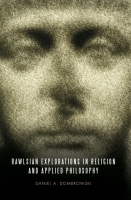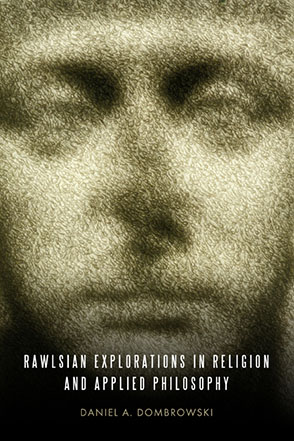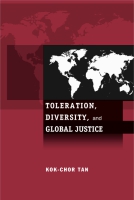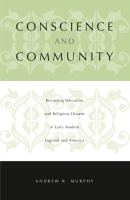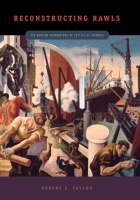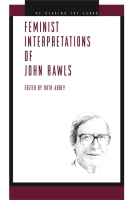Rawlsian Explorations in Religion and Applied Philosophy
Daniel A. Dombrowski
“Daniel Dombrowski’s book is an important contribution to our understanding of the implications of Rawls’s political theory for law, policy, politics, and religion. It uses justice as fairness to shed light on many issues—war, animal rights, affirmative action, and religious diversity in a democratic society—that have been relatively neglected in the literature on Rawls. Dombrowski brings to the task both analytic precision and a religious sensibility, and his ability to tease out the often hidden religious assumptions and implications of Rawls’s theory is impressive. Moreover, the concrete positions that Dombrowski stakes out—support for pacifism and animal rights, opposition to legacies and affirmative action—are controversial, especially from within a Rawlsian framework, and they should deservedly garner the book much scholarly attention.”
- Description
- Reviews
- Bio
- Table of Contents
- Sample Chapters
- Subjects
“Daniel Dombrowski’s book is an important contribution to our understanding of the implications of Rawls’s political theory for law, policy, politics, and religion. It uses justice as fairness to shed light on many issues—war, animal rights, affirmative action, and religious diversity in a democratic society—that have been relatively neglected in the literature on Rawls. Dombrowski brings to the task both analytic precision and a religious sensibility, and his ability to tease out the often hidden religious assumptions and implications of Rawls’s theory is impressive. Moreover, the concrete positions that Dombrowski stakes out—support for pacifism and animal rights, opposition to legacies and affirmative action—are controversial, especially from within a Rawlsian framework, and they should deservedly garner the book much scholarly attention.”
“Despite the immense secondary literature on the work of John Rawls, there has been relatively little that aims to explore the application of his approach to more concrete issues. This is exactly what Dombrowksi provides, extending and applying justice as fairness in discussions of war, mental disability, animals, affirmative action, and religion. While sympathetic to Rawls’s basic approach, Dombrowksi does not shy away from criticizing some of his brief comments in these areas. He also engages productively with the work of Nicholas Wolterstorff, Michael Walzer, and Martha Nussbaum, among others. Consistent with the idea of reflective equilibrium, which Dombrowski discusses insightfully, the arguments that he constructs concerning these more concrete matters also have some important and surprising implications for the more abstract principles themselves. It is a very welcome addition—and makes a distinctive contribution—to the literature on Rawls.”
“This critical appreciation and application of John Rawls’s achievement is the more distinctive because political liberalism is here integrated with process metaphysics. Dombrowski is entirely familiar with the relevant literature defining both discussions and, in addition, with recent treatments of several vexing contemporary issues that focus these chapters, and his analyses are detailed and judicious throughout. The result, while recognizably Rawlsian, is thoroughly Dombrowski’s own and is a marked contribution to the conversation, both on political philosophy and on the difference philosophy makes to specific political problems.”
“In this clear and accessible book, Daniel Dombrowski brings the political philosophy of John Rawls to bear on a number of topics of great practical interest: war, disability, animal rights, legacy admissions, affirmative action, and religious belief. Dombrowski’s explorations are informed by an expert knowledge of Rawls’s texts, by the latest scholarship, and by his own deep acquaintance with process thought. Dombrowski is therefore able to extend and challenge Rawls’s thought in original and provocative ways that thoughtful readers of Rawls will find most instructive.”
Daniel A. Dombrowski is Professor of Philosophy at Seattle University.
Contents
Preface
1 Rawls, Natural Rights, and the Process of Reflective Equilibrium
2 A Rawlsian View of War
3 Nussbaum, Mental Disability, and Animal Entitlements: A Rawlsian Perspective
4 A Rawlsian Critique of Legacy and Affirmative Action
5 “All for the Greater Glory of God”: Was Saint Ignatius Irrational?
6 Rawlsian Religion
References
Index
Preface
One of the most common criticisms of John Rawls’s political philosophy is that it is “too abstract.” Sometimes this criticism is leveled against Rawls by those who lack the time or training to work through his admittedly difficult writings. But at other times it is used by scholars who are bothered by the distance between Rawlsian theory and the actual political world in which we live. As one colleague, after reading Rawls carefully, put it, one does not know how to get from “here” to “there” in Rawls, “there” being the realistic utopia that Rawls had in mind.
Admittedly, there are very good reasons why Rawls’s thought is so abstract. In order to deal with the questions that were central to A Theory of Justice, Rawls was led to social contract theory, but only to a version that was raised to a higher level of abstraction than that found in traditional social contract theorists (Rawls 1996, xvii). This need for a greater degree of abstraction is amplified in his later writings, wherein citizens are seen to differ, sometimes uncompromisingly so, in the comprehensive doctrines that they are willing to affirm (which are very often religious in character), such that the differences themselves generate the process of abstraction so as to achieve the higher ground that is required to understand what a just society (or a just international order) would be like. That is, by abstracting from the social world we are able “to gain a clear and uncluttered view” (Rawls 2001, 8) of the subject matter so as to deal appropriately with a few crucial questions. Rawls is rightly adamant that he does not need to apologize for the abstract and supposedly unworldly character of his philosophy (Rawls 1996, lxii).
It should be noted, however, that one need not apologize for the desire to make philosophical ideas concrete, either. As Alfred North Whitehead observed, “The true method of discovery is like the flight of an aeroplane. It starts from the ground of particular observation; it makes a flight in the thin air of imaginative generalization [think of the original position]; and it again lands for renewed observation rendered acute by rational interpretation” (1978, 5). To continue with this metaphor, the present book is meant to facilitate the landing of Rawls’s theoretical craft, the most important in political philosophy since at least the time of the Wright brothers.
To be precise, this book is intended to fill the gap between Rawls’s own empyrean heights and the really practical public policy proposals of government planners, lobbyists, and legislators. From the perspective of the latter, what I do in this book will look very theoretical and philosophical, whereas from the perspective of political philosophers, what I do in this book may appear somewhat pedestrian. But there is nothing wrong with walking. Indeed, the whole point of theoretical flights in political philosophy is to facilitate better walking. As I see things, both words in the title of the book are crucial: applied philosophy.
No doubt one of the reasons why Rawls did not do more in the area of applied philosophy was his fear that philosophers who achieve celebrity status in popular culture see their best arguments misunderstood and hence the philosophical enterprise itself diluted. But Rawls himself stresses the importance of nonideal theory as well as ideal theory, at least as long as the latter guides the former. In any event, Samuel Freeman astutely alerts us to the fact that the great political philosophers of the modern period have typically had their greatest practical influence in the centuries after they wrote: Locke lived in the seventeenth century but greatly influenced the revolutions of the eighteenth; Smith lived in the eighteenth century, but his greatest influence was in the nineteenth and twentieth; Marx lived in the nineteenth century, but the communist revolutions in his name occurred in the twentieth. It is not unreasonable to hope that liberal democracies in the twenty-first century will be more Rawlsian than they were in the twentieth (see Freeman 2007b, 5, 458, 472; Pincus 2009). Further, the recent collapse of communism in eastern Europe and the recent financial crisis brought about by a relatively unconstrained version of capitalism provide apertures for Rawlsians to think anew about the praxic implications of justice as fairness.
The “in-between” status of the present book is not unique, in that excellent work has been done over the past several decades (most recently by Freeman, Thomas Pogge, and Percy Lehning) in exploring the implications of Rawls’s thought for practical issues like the just distribution of income, fair tax practices, inherited wealth, universal health care, defensible relations between church and state, the elimination of “the curse of money” on politics, and so on. But, as I see things, there is still significant “in-between” work to be done in several important areas, six of which are explored here. The problems that I examine mostly involve religion, either problems in political liberalism that bear on religion or problems in religion that bear on political liberalism.
My hope is that the “in-between” status of this book will actually make it instructive for scholars who are primarily interested in the intrinsically interesting theoretical issues in Rawlsian political philosophy, in that critical assessment of theoretical positions requires, in part, a consideration of how they play out in practice. It is also my hope that the book will be instructive for those whose interests in politics are primarily practical, in that solutions to practical problems are often stalled owing to disagreements at the theoretical level. That is, because neither theory nor practice can be conveniently ignored in political philosophy, the “in-between” status of the present book can be seen as one of its virtues.
In chapter 1 I try to explain and defend the Rawlsian method of reflective equilibrium. In this regard I enter into dialogue primarily with the traditional theist Nicholas Wolterstorff and his defense both of natural rights and of the (startling) claim that Rawls is a natural rights theorist. I emphasize that reflective equilibrium involves a process of justification, rather than a strictly ahistorical, algorithmic appeal to the deliberations that occur in the original position. This chapter is preparatory for the rest of the book because it enables us to understand the very practical ramifications of finding a place for natural rights in the Rawlsian universe. It also enables us to understand the transition from considered judgments to unconsidered consequences that characterizes applied philosophy in general. In this chapter I also discuss the thorny issue of how to justify the belief that human beings deserve political respect without Wolterstorff’s appeal (and Rawls’s own appeal, albeit at a very early stage of his career) to the imago Dei hypothesis that human beings are made in the image of God.
The second chapter explicates Rawls’s complex views regarding the morality of war. I show that his stance is, for the most part, that of a just war theorist in the mold of Michael Walzer. Unfortunately, however, Rawls is also like Walzer in moving away from just war theory toward the realpolitik view of war in conditions of supreme emergency. I argue that Rawls’s best contributions to political philosophy would be enhanced if he moved in the opposite direction, away from just war theory and toward pacifism. That is, I think that Rawls is sometimes mistaken about what he has discovered both in political philosophy proper and in terms of the practical ramifications of his discoveries. The long history of the religious tension between just war theory and pacifism is brought to bear in this chapter. I challenge Rawls’s belief that principled opposition to war is more probably the result of religious conviction than of philosophical argument.
In chapter 3 I confront the difficult issue of how to deal with those nonrational yet sentient beings who have historically been left out of the social contract tradition: both mentally deficient human beings and nonhuman animals with central nervous systems. Here my interlocutor is Martha Nussbaum, whose capabilities approach supplements, rather than contradicts, Rawlsian social contract theory, on my interpretation. Further, I argue that the compatibility between the capabilities approach and social contract theory can be strengthened in terms of a revised original position that is more friendly toward the marginal cases of humanity and nonhuman animals than Rawls’s own version of the original position. Here I confront the traces of the imago Dei hypothesis even in Rawls’s later writings, specifically the anthropocentric character of that hypothesis, despite its ostensive theocentrism.
Chapter 4 is not as obviously concerned with religion as the other chapters, although even here I think it is fair to say that (a) defenders of legacy are the remote inheritors of the divine right of aristocracy and noblesse oblige, and (b) defenders of affirmative action often equate the quasi-religious and understandable battle against racism—e.g., the abolitionists were basically divine command theorists and Martin Luther King was a natural law theorist—with the questionable practices involved in affirmative action. In this chapter I try to supplement Robert Taylor’s important treatment of this subject.
The fifth chapter deals with a crucial theoretical issue involved in the Rawlsian effort to understand how religious belief is compatible with responsible citizenship in a politically liberal society. Because many or most citizens in contemporary democracies are religious believers of some sort, the practical import of this understanding is hard to exaggerate. And the fact that many nonliberal societies are dominated by a certain kind of intolerant religious belief makes this issue especially important. Here I am especially concerned with Freeman’s and Pogge’s interpretations of issues related to religion and politics.
All of the chapters in the book can be seen as extended addenda to my previous book on Rawls, Rawls and Religion: The Case for Political Liberalism, although the present book is intended to stand on its own and requires no familiarity with the previous work. The final chapter of the book is especially relevant in this respect. In this chapter I am concerned not so much with the implications of Rawls’s political philosophy for issues related to religious beliefs but with Rawls’s own religious beliefs themselves, or lack thereof. But even in this chapter my concerns will be Rawlsian rather than limited to Rawls’s own religious beliefs or nonbeliefs.
In one sense it would have been appropriate to begin the book with the final chapter. However, because Rawls never intended that either of the texts involved—his very early undergraduate senior thesis while at Princeton and his very late testimony “On My Religion”—be made available to the public (they were published only posthumously, in 2009), I thought it best to conclude the book with this chapter. I want to show that the previous chapters can stand on their own without the (fascinating) evidence discussed in the last chapter.
My goal is not merely to trace the implications of Rawls’s thought for these areas of philosophy but to illuminate these areas themselves. It is not self-evident how we are to think about natural rights, war, nonhuman animals, legacy and affirmative action, and religious belief in a democratic society. We very often need theory to understand and label, in some cases even to notice, the phenomena in question. That is, the project is rescued from any sort of Rawls scholasticism when it is noticed, again, that the title of the book refers to Rawlsian explorations rather than exegesis of Rawls’s own texts. My goal is quite frankly to use Rawlsian insights so as to better understand several important practical problems in contemporary political life that matter to all of us, or to almost all of us.
I should also note the word “explorations” in the title of the book. As Whitehead once again puts the point, “the merest hint of dogmatic certainty as to finality of statement is an exhibition of folly” (1978, xiv). I try, nonetheless, to defend my views energetically, not because I believe that intensity of conviction translates into justificatory warrant but so as to play my part in the philosophical enterprise as well as I can. This enterprise is inherently dialectical, as I argue in chapter 1. My hope is that a spirited defense of certain theses will elicit equally spirited responses from scholars, in particular, and from those interested in approximating a just society, in general.
Finally, a word about my synoptic view of Rawls’s career, a view that necessarily informs this book. Perhaps the key issue that has dominated Rawls scholarship since the publication of Political Liberalism in 1993 is the relationship between the early and late Rawls. Clearly there is a great deal of both continuity and discontinuity between this work and A Theory of Justice (1971). The major discontinuity is that his view in the earlier work was often, but not always, articulated in terms of what he later called a comprehensive doctrine. His stance in later works was articulated in the more modest terms of political liberalism.
The overall thrust of my treatment of Rawls is based on the continuity in his writings. Here I follow Freeman rather closely. It should be noted that justice as fairness, the original position, the veil of ignorance, the priority of the right to the good, the two principles of justice, and so on, are all retained in the later Rawls under the umbrella term “political liberalism”; hence I will switch back and forth without qualification between “justice as fairness” and “political liberalism.” Of course, I also indicate, when appropriate, where the views found in the early Rawls deviate from those in the later Rawls and where justice as fairness is not to be seen as equivalent to political liberalism, in that the latter designation is, to be precise, generic and includes justice as fairness as only one of its specific instances. An example of where the early Rawls differs from the later Rawls can be seen in his concept of stability: in the early Rawls stability is explicated primarily in terms of congruence (between the right and the good), whereas in the later Rawls stability is explicated in terms of overlapping consensus. For the most part, however, Political Liberalism and other later writings build on or clarify A Theory of Justice, in my view.
There are four notable discontinuities between the early and late Rawls: (1) In A Theory of Justice there is no clear distinction, as there is in Political Liberalism, between moral philosophy in general and political philosophy in particular; (2) thus there is no clear distinction in A Theory of Justice, as there is in Political Liberalism, between a moral, comprehensive view of justice and a political conception of justice; (3) the idea of stability as congruence in A Theory of Justice is especially problematic, in contrast to the concept of overlapping consensus in Political Liberalism; and (4) Rawls admits in Political Liberalism that he had underestimated, in A Theory of Justice, the difficulty of making his idea of a well-ordered society consistent.
But these discontinuities between the two works are still perfectly compatible with an overall thesis of continuity. In fact, in order to even understand the nature and extent of the problems listed in the previous paragraph, one must see them as arising from a point of view internal to justice as fairness as that concept is developed in both the 1971 book and the 1993 book. Rawls himself speaks of a “unity” of both “spirit and content” in A Theory of Justice and Political Liberalism. Once the problems in the previous paragraph are addressed, the structure and content of the two books are, as Rawls notes, “the same.” The ambiguities in A Theory of Justice are largely cleared up by presenting from the outset the idea of justice as fairness as a political, rather than as a comprehensive moral, conception (Rawls 1996, xvi–xix).
It is crucial for my aims in this book to emphasize that the major contributions of Rawls’s later works are largely a result of Rawls’s own explorations in religion and applied philosophy. It is my hope both to better understand and to expand on these contributions.
Mailing List
Subscribe to our mailing list and be notified about new titles, journals and catalogs.
